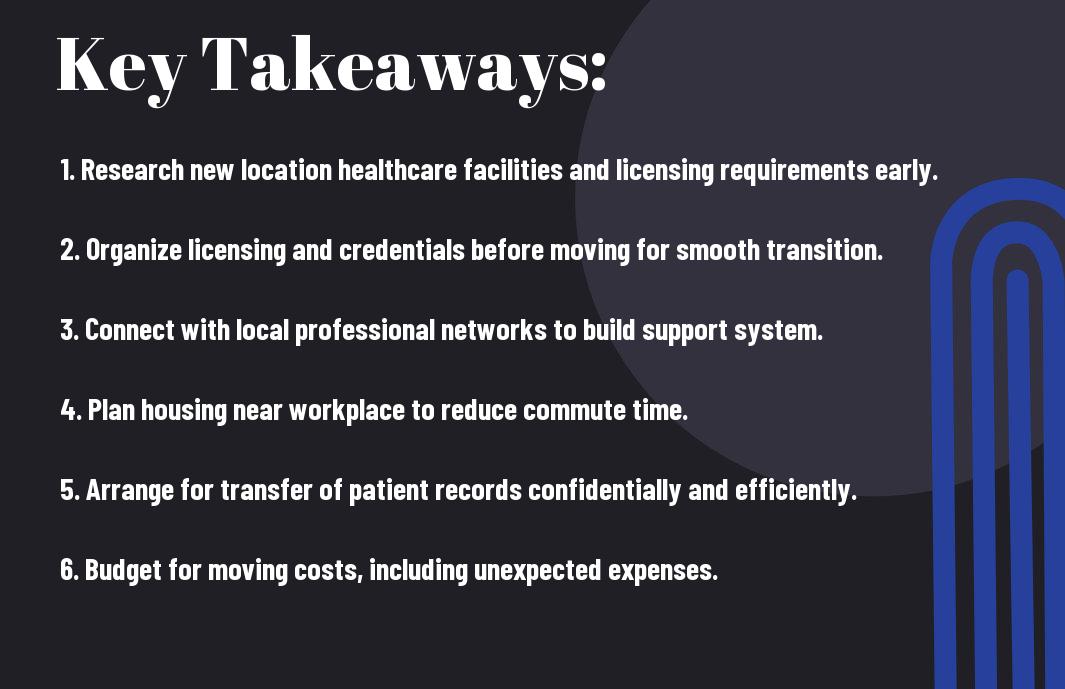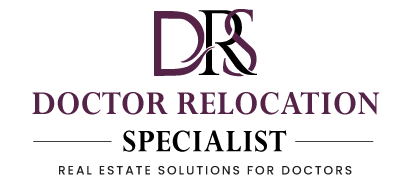Just when you think you’re ready to take the next step in your healthcare career, the relocation process can feel overwhelming. To make your transition smoother and more efficient, it’s vital to have a plan in place. In this post, you’ll discover vital tips tailored specifically for healthcare professionals like you, to help streamline your move. From organizing your paperwork to finding the right resources in your new location, we’ll guide you through the steps necessary to ensure a seamless transition as you initiate on this exciting new chapter.

Navigating the Transition: Key Considerations for Healthcare Professionals
Transitioning to a new work environment as a healthcare professional involves several key considerations that significantly affect your move. Understanding the local healthcare landscape and regulatory requirements can streamline your integration. Familiarize yourself with state licensure processes and any continuing education credits needed for your new role. Moreover, connecting with local professional organizations can provide invaluable support and resources as you establish yourself in the community.
Assessing Job Opportunities in Your New Location
Identifying potential job opportunities in your new area is necessary for a smooth transition. Start by researching healthcare facilities, clinics, and organizations that align with your specialty. Utilize job boards, local recruitment agencies, and networking events to uncover openings. Engaging with colleagues through social media platforms like LinkedIn can also yield job leads and insights into the work culture of prospective employers.
Evaluating Cost of Living and Housing Options
Before relocating, meticulously assess the cost of living and housing options in your new city. This analysis should include comparing average salaries for your profession against housing prices, transportation costs, and everyday expenses in the area. Websites such as Numbeo and Zillow can provide detailed insights into rental rates, utilities, and overall affordability. Taking the time to evaluate these factors will ensure you make a financially sound decision that aligns with your lifestyle and career goals.
Exploring housing options extends beyond just rent or mortgage payments; assess neighborhoods based on proximity to your workplace, safety ratings, and community amenities. Consider areas with good public transport links if you rely on commuting. Researching local schools, parks, and healthcare facilities can also enhance your quality of life and ensure a seamless transition for any family you may be relocating with. Create a realistic budget that encompasses all expenses related to housing and the overall cost of living to avoid any financial surprises down the line.
The Logistics of Relocation: Crafting a Smooth Move
Policies, paperwork, and physical belongings all come into play during your move. Coordinating these logistics is necessary to ensure that your relocation is efficient and organized. Begin by assessing your current situation and outlining your needs—consider your new job’s start date, housing arrangements, and any family obligations. By carefully managing each aspect of your move, you can significantly reduce stress and enhance the transition process for you and your loved ones.
Planning Your Timeline: Essential Milestones
Creating a timeline for your relocation is vital for keeping your move on track. Set specific milestones, such as finding a new home, securing a moving company, and packing your belongings. Aim to establish your timeline well in advance—ideally 8-12 weeks before your move. This structured approach allows you to allocate time for unexpected challenges and ensures everything is in place for your new chapter.
Selecting the Right Moving Company: What to Look For
Choosing the right moving company can make your relocation seamless. Look for movers with positive customer reviews, comprehensive insurance options, and transparency regarding pricing. A flexible and communicative team can also ease your mind during an otherwise hectic process. Take the time to research and interview potential candidates to evaluate their expertise and align them with your specific needs.
Prioritizing experience matters when selecting a moving company, particularly for your healthcare-related needs. Verify their track record with relocations in the healthcare sector by asking for references or examples of past client experiences. Ensure they are knowledgeable about regulations pertaining to transporting medical equipment, if applicable. By narrowing down your options based on industry-specific qualifications, you can boost the likelihood of a smooth and hassle-free move.
Licensing and Credentialing: Ensuring Career Continuity
Before starting your new position, securing the necessary licenses and credentials is crucial to ensure you can practice smoothly in your new location. Each state has unique regulations, which require time and diligence to navigate. Familiarize yourself with the specific evaluation and verification processes required by your new employer, as well as any additional documentation needed to maintain your professional standing.
Understanding State-Specific Requirements
Diverse regulations exist between states, so be proactive in researching the specific licensing requirements for your medical profession in your new location. Sites like the Federation of State Medical Boards or your individual licensing board can provide valuable information regarding education, examinations, and renewal processes tailored to your discipline, helping you avoid delays in starting work.
Expediting the Credentialing Process
The credentialing process can often seem daunting, but there are several strategies to expedite it. Start by gathering all required documentation, including proof of education, malpractice history, and work history. Consider using a credential verification organization (CVO) capable of handling this process quickly and efficiently. Being organized and responsive will help the process run smoothly, so stay in close contact with your future employer’s HR or credentialing department to address any potential issues head-on.
Utilizing a CVO can significantly shorten the credentialing timeline. These organizations specialize in gathering and verifying your credentials and often have established relationships with healthcare facilities, which helps streamline communication. By assembling all your documents ahead of time and ensuring they are complete, you minimize the chances of delays. Actively participating in the process—responding quickly to requests and supplying documentation as needed—will demonstrate your commitment and professionalism, further expediting your credentialing journey.
Building a Support Network: Establishing Community in a New Area
Creating a strong support network in your new location can significantly ease the challenges of relocation. Establish relationships with fellow healthcare professionals and community members, as social connections can provide you with both personal support and professional opportunities. Attend community events, engage in local volunteer work, and hold onto connections made during your transitional journey to build lasting relationships. Understand that establishing community ties can benefit not only your personal well-being but also your career advancement.
Connecting with Local Healthcare Providers
Reaching out to local healthcare providers is instrumental in establishing a professional network. Attend local workshops or seminars and introduce yourself to colleagues in your field. By engaging with them, you can share experiences, discuss best practices, and stay informed about the healthcare landscape in your new location. This collaboration can also open doors for potential job opportunities, referrals, and mentorship.
Leveraging Professional Organizations to Expand Your Network
Joining professional organizations tailored to your specialty can significantly enhance your networking efforts in a new area. Research available organizations in your field, participate actively in events, and engage with online platforms to meet industry peers. Membership often includes access to valuable resources, training opportunities, and forums for discussion, all of which can help you connect with others facing similar challenges or successes.
Professional organizations often host conferences, workshops, and networking events that facilitate relationships between members. For example, organizations like the American Nurses Association or the American Medical Association provide an array of networking resources, helping you not only make professional connections but also to gain insights into the latest advancements in healthcare. These environments foster collaboration, learning, and community, allowing you to seamlessly integrate into your new professional landscape while building a solid foundation for your career.

Settling In: Adapting to Your New Work Environment
As you settle into your new role, immersing yourself in the culture of your workplace and community can enhance your experience. Connect with colleagues by taking part in team meetings and social events, allowing you to foster relationships that support your integration into the team. Observe the dynamics, communication styles, and protocols within your new healthcare setting, which will guide you in adapting your approach to align with the expectations of your new environment.
Understanding Cultural Differences in Healthcare Practices
Each healthcare setting bears its own cultural nuances, influenced by local traditions and practices. Familiarizing yourself with these unique aspects, such as patient interactions, decision-making processes, and community health beliefs, prepares you for effective communication and collaboration. Engage with local health professionals and attend workshops to deepen your understanding of the regional healthcare landscape, ensuring you provide culturally competent care.
Establishing Work-Life Balance in a New Setting
Adapting to a new work environment presents distinct challenges, especially when it comes to maintaining a healthy work-life balance. Establish clear boundaries between your professional and personal life, ensuring you carve out time for relaxation and self-care. Utilize time management techniques to prioritize your tasks effectively, allowing you to leave work at work and recharge at home.
Setting yourself up for success involves proactive planning. Consider creating a structured daily routine that carves out specific times for work responsibilities, exercise, and leisure activities. Establishing a support network comprising friends, family, or colleagues can also provide emotional grounding, making it easier to navigate your new environment. As you strive for equilibrium, aim to incorporate activities that nourish your well-being, such as pursuing hobbies or exploring local attractions, ensuring that your professional commitments are balanced with personal fulfillment.
Conclusion
Considering all points, relocating as a healthcare professional can be a seamless experience if you plan effectively. By prioritizing your needs, researching your new location, and organizing your logistics, you can ensure a smooth transition. Utilize available resources to assist with job placements, housing, and community integration. This strategic approach will help you focus on your career and personal well-being as you begin on this new chapter in your professional journey.

